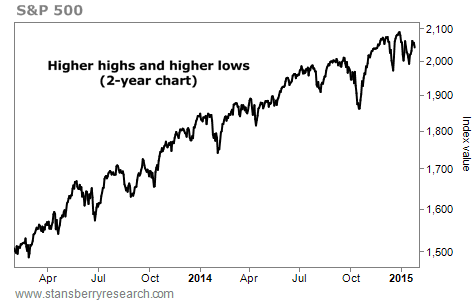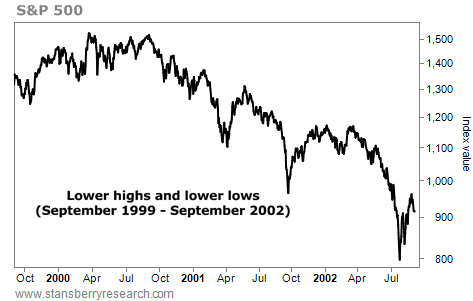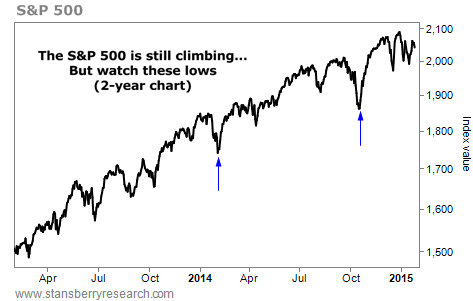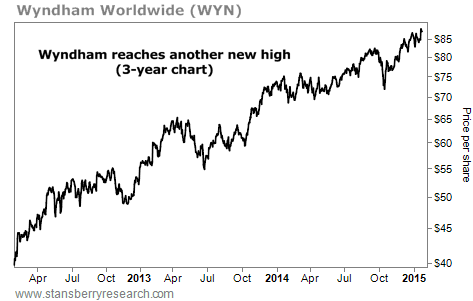| Home | About Us | Resources | Archive | Free Reports | Market Window |
How You'll Know When a Bear Market Has ArrivedBy
Wednesday, January 28, 2015
In Monday's issue of Growth Stock Wire, we shared a common sense plan for staying long stocks as the market trends higher... while having an exit plan in place in case a bear market begins.
Since some market analysts say a bear market is around the corner, we know this is a big concern for many investors.
But how do you know when a bear market has actually arrived?
The number one thing that would lead us to think a bear market has officially arrived is something called "lower highs and lower lows."
Markets don't move in smooth, straight lines. They move in stair steps. A bull market tends to take a few steps higher... then a step or two lower. The steps forward are larger than the steps backward, and this produces price gains over time.
You can see a series of "higher highs and higher lows" in the two-year chart of the S&P 500 below:
 A bear market works the opposite way. In a bear market, the market tends to take a few steps lower... then a step or two higher. The steps lower are larger than the steps higher, and this produces losses over time.
You can see a series of "lower highs and lower lows" in the chart of the S&P 500 from late 1999 through late 2002:
 Now, let's look at the current state of the market...
There are two important lows to monitor. One is the low set on October 16, 2014. This is the lowest point the sellers could push the market during the sharpest market correction last year. The other notable low of the year came on February 3.
 If the October low is breached, the now-six-year old bull market has likely ended. If the market keeps heading lower and breaches the February low, we'll believe a bear market has officially arrived.
We know this analysis may sound simplistic. But the best analysis tools are almost always simple, and based on common sense. That's why, if you're concerned about a bear market, you should stay on the lookout for "lower highs and lower lows." It's the hallmark of bear market price action... And it means you should be cautious toward stocks.
We'd rather see a continuation of the bull market. Rising stock prices are better for the country than plummeting stock prices. But the bull market is getting old. As top money-management firm DoubleLine recently pointed out, since 1871, the market hasn't been able to string together seven consecutive winning years.
Still, our colleague Steve Sjuggerud rightly points out that the market can head higher from here. (He makes the case that stocks today are slightly more expensive than normal... but they haven't reached "bubble valuations.")
We can't know the future. But we can stay aware of the risks out there. That means staying on the lookout for "lower highs and lower lows."
Regards,
Brian Hunt and Ben Morris
Further Reading:
To judge whether stocks are cheap or expensive, Dr. Steve Sjuggerud invented a proprietary indicator... It takes both the market's price-to-earnings ratio and the country's economic situation into account. Get Steve's take – and see his indicator – right here.
Using a system of "common sense technical analysis" can dramatically increase your investment and trading returns. Learn more about timing your trades – and a few more simple technical indicators – in this classic interview with Brian.
Market NotesIS THE ECONOMY REALLY THAT BAD? Many folks are worried about the U.S. economy... but today's chart reminds us that things "can't be all that bad" in America.
Over the past three years, we have published dozens of charts that proved America was doing a heck of a lot better than the pessimists would have you believe. One of the clearest signals, we've often said, is the climbing revenue and share price of Wyndham Worldwide (WYN). It's one of the most important stocks most people have never heard about.
Wyndham Worldwide is the world's largest hotel chain. Brands here include Super 8, Howard Johnson, Ramada, and Days Inn. Wyndham owns several "upscale" hotel chains as well. The fortunes of hotels rise and fall with America's propensity to take business trips and vacations... so they're a good indicator of what's going on in the economy.
As you can see from the three-year chart below, things are going well. Wyndham's strong business has helped shares climb more than 100% in the past three years. And just last week the stock hit a new all-time high. It's more proof that America is doing a lot better than the pessimists would have you believe.
 |
Recent Articles
|



